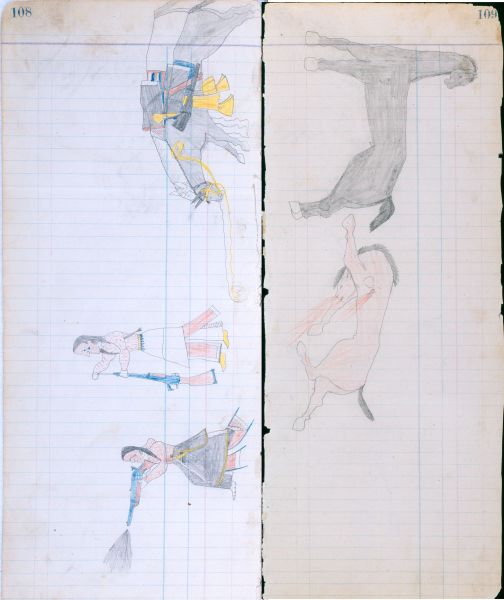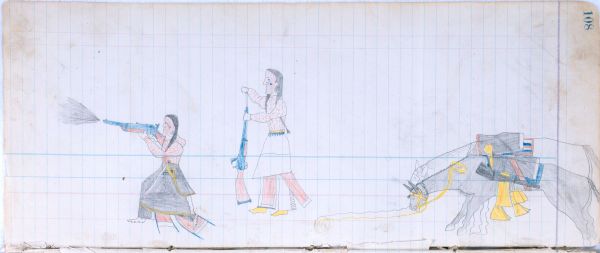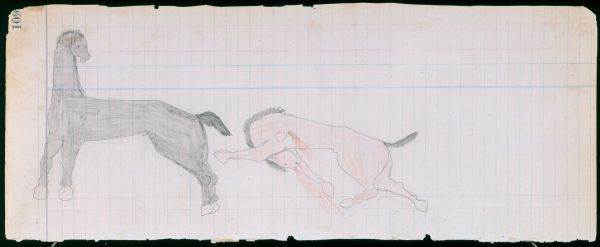PLATE 108-109
Ethnographic Notes
This seemingly strange composition is more evidence for the encroachment by White ranchers on Cheyenne territory south of the Arkansas River in 1874-75. On its left shoulder, the dead bay stallion in Plate 109 bears a heart-shaped brand that will recur in Plate 112. None of the Southern Plains was fenced at this time, so alien stallions introduced by cattle companies, if allowed to roam, could follow the wind-borne scent of Cheyenne-owned mares. Such an intrusive horse has here attacked a stud belonging to Arrow's family, trying to usurp and run off with their herd. Arrow and his relative are dealing summarily with the problem. They shall then follow the stallion's trail back to where he came from, and in Plate 112 are seen removing the potential source of future problems.
Here, Arrow is the man kneeling in the foreground, as we may be assured by the fact that it is HIS bullet striking the stallion, and that his yellow vaquero saddle is also in the foreground. The animal carrying it is probably intended as a mule---note the long ears and cropped mane. The dark-leather rifle scabbard, suspended upside down from the saddle, was either borrowed for the occasion, or was soon traded off, for Arrow shows an improved case by Plate 120.
Also note the absence here of fancy, colored saddle cloths, or excess blankets, such as Arrow and his comrade loaded on their horses when they intended to go courting in Plates 88 & 102. The blanket is secured around his waist with a cartridge belt for his 44-caliber Ballard carbine---the same weapon Arrow captured in Plate 13; compare Woodhead, 1992: 62-63. A knife in a sheath decorated with brass tacks along the curved edge is carried on the cartridge belt.
Arrow wears the same plain, dark blue trade cloth leggings, and fully-beaded moccasins seen often before. His red wool breechcloth is accented with blue silk ribbons, but in a pattern not repeated elsewhere; and he wears a calico shirt that has a pattern of red stripes and polka dots.
Arrow's partner wears a red polka-dot calico shirt, white-blanket leggings with fringed sides, a red breechcloth, and yellow-painted moccasins. A wrap of muslin or light canvas is around his waist, secured by a belt holding .50-70 center-fire cartridges for his 1870 model trapdoor Springfield rifle (compare Steffen, 1978: 102). The purpose of Arrow's drawing is to show that his friend has already fired---and missed. Then with a brilliant shot, Arrow succeeds where the other has failed. The friend also has a problem, one that was common to the Springfield: a cartridge has jammed in the chamber, and he is reduced to forcing it out with a ramrod.
The 7th U.S. Cavalry was armed with 1873 model trapdoor Springfield carbines at the Little Bighorn in 1876, less than two years after the problem depicted here by Arrow. Major Marcus Reno, who commanded the portion of the 7th which survived the battle, wrote to the Chief of Ordnance on July 11, 1876:
"...in the engagement of the 25 & 26 June 1876...out of 380 carbines in my command six were rendered unserviceable in the...failure of the breechlock to close...& when the piece was discharged, & the block thrown open, the head of the cartridge was pulled off & the cylinder remained in the chamber, whence with the means at hand, it was impossible to extract it" (quoted in du Mont, 1974: 27).
The face paint of both men is significant in this hunting context---a background of red, with zigzag lines of lightning issuing from their eyes. The Cheyenne belief is that lightning shoots out from the eyes of the Thunderbird, which seldom misses its target. Both of these men are members of the Crooked Lance, or Elk Society, which "seemed especially to reverence the Thunder" (Grinnell, 1923, II: 59). In the Crooked Lance war party parade shown in Plate 163, when Arrow and this same comrade ride off together to hunt MEN, they will again conjure the deadly glance of Thunder.


